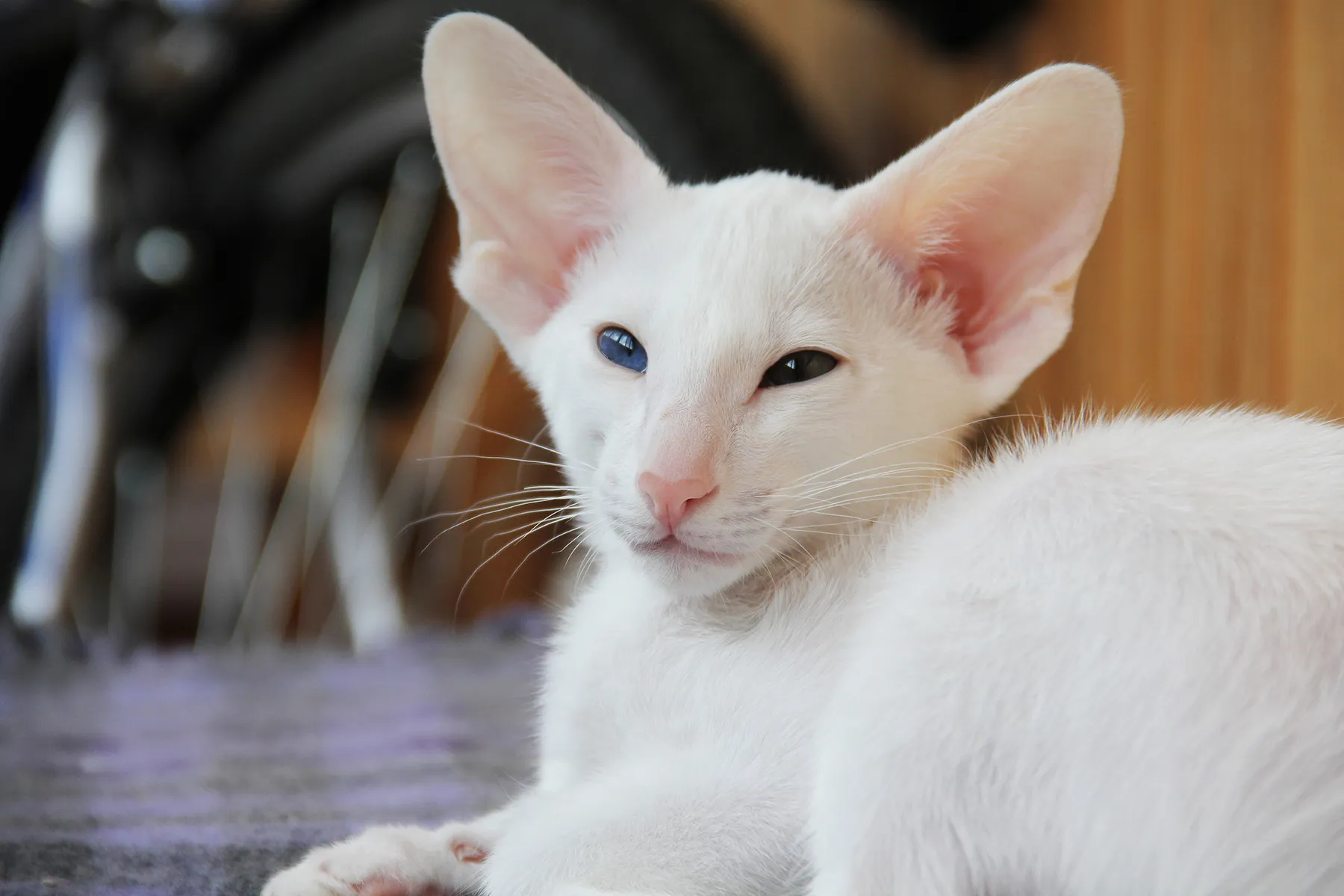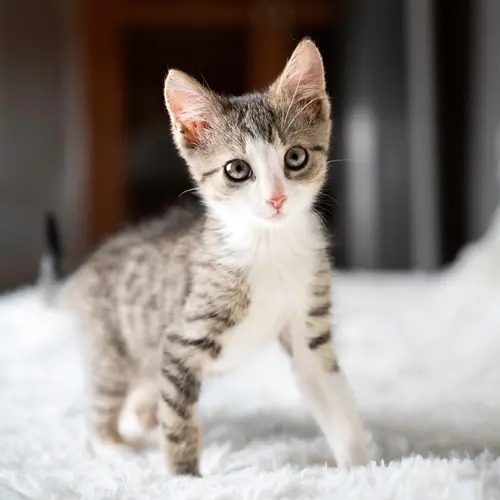
Oriental cats come in two varieties — longhaired and shorthaired. The only difference between these two varieties is the length of their coats. All of their other characteristics are essentially the same.
These cats are part of the Siamese breed group. They look and behave like a typical Siamese. They’re long, lean, and full of loving energy. Oriental cats are a very popular purebred breed. They get along nicely in a wide variety of homes.
Characteristics of the Oriental Cat
Body size. The Oriental cat size is small to medium for a typical cat breed. Healthy cats should weigh an average of seven to 12 pounds. Make sure to talk to your veterinarian if you’re concerned that your cat is too far underweight or overweight.
Body shape. Like most Siamese-type cats, Oriental cats have very fine bone structures. But this doesn’t mean that the cats are fragile. Instead, they should have strong musculature overlaying their elegant frames.
Their long legs end in tiny, round feet. Their legs are long and typically taper to a fine point. Shorthaired versions have whippy tails, while longhaired ones are heavily plumed.
The Oriental head looks like a triangle from the front. They’re wedge-shaped and taper to smooth muzzles. These heads are topped by large ears that are wide at the base.
Lifespan. The Oriental cat's lifespan is longer than that of some cat breeds. On average, the cats can live anywhere from 15 to 20 years.
Coat. Your Oriental cat will have either a long or short coat. The long coats result from a recessive mutation. You need two copies of the gene for a long coat to have one. Longhaired kittens will only produce all longhaired litters when they’re crossed to other longhaired members of the breed.
The short coats are glossy and lie close to the cats’ bodies. The longhaired varieties are only considered semi-longhairs. Their coats drape over their bodies.
Orientals are one of the most colorful breeds of cats. You can find up to 300 combinations of coat colors and patterns. Any combination of color and pattern that you can find in a shorthair also exists as a longhaired version. If you have a favorite color combination in a cat, then there’s a matching Oriental pet for you.
Available colors include:
- White
- Red
- Cream
- Ebony
- Blue
- Chestnut
- Lavender
- Cinnamon
Eyes. Oriental cats have almond-shaped eyes. They’re set at a noticeable angle in the skull. Unlike in Siamese cats, the preferred eye color is green. But you may occasionally see the blue eyes more typical of Siamese cats popping up within this breed.
Personality. The Oriental cat's personality is that of a loving and affectionate playmate. They’re incredibly social cats who always want to know what’s happening around them.
These cats are self-confident and parade around your home like they own the place. They’re also very talkative and will likely try to tell you all about their day when you get home from work each night.
Oriental cats thrive on your attention, so don't ignore them for too long, or they’ll become disheartened.
Caring for the Oriental Cat
Grooming. Grooming the shorthaired and longhaired versions of the Oriental cat is straightforward. You should occasionally run a brush or comb through their fur to clean and make it glisten.
It would help if you also brush your cat’s teeth once a week with cat-safe toothpaste. This prevents dental disease. Check their ears for signs of debris regularly. You can gently clean these areas with cotton balls. Trim their nails every few weeks to complete their grooming routine.
Feeding. Consult your veterinarian for the most accurate feeding advice for this breed. Your cat will have different dietary needs depending on their age. For example, kittens and older cats can have unique nutritional requirements.
Oriental cats are particularly energetic, so it’s typically safe to freely leave out kibble for them. Even with open access to food, they rarely have a problem with obesity.
Cats don't always get enough to drink. Make sure that your pet has access to clean, fresh water at all times. You can try changing things up, like using a flowing fountain and making sure that the bowl is full to the rim.
Exercise and mental stimulation. Oriental cats need plenty of physical and mental stimulation to burn their excess energy. They love playing with toys and can entertain themselves for hours if you provide enough entertainment. This can be as simple as a cardboard box that they’ll jump in and out of for extended periods.
Some Oriental cats can even be trained to play fetch. They thoroughly enjoy your attention and will have fun playing with you.
You should also make sure to provide your cat with a scratching post or somewhere safe for them to sharpen their claws. This is an instinct that your cat needs to fulfill.
Veterinary visits, medications, and immunizations. All cats need vaccinations and other veterinary assistance throughout their lives.
Core vaccinations should be given and recorded on their health record. This includes vaccinations for:
- Feline distemper
- Feline herpes virus
- Calicivirus
- Rabies
Non-core vaccinations are optional and should be discussed with your veterinarian. Non-core vaccinations cover problems like feline leukemia.
It's not uncommon for cats to get fleas. You can get medications from your veterinarian or other distributors. Use them at any time of year that your cat needs them.
Like dogs, cats can get heartworms too. Unfortunately, there's no treatment. Instead, you should focus on prevention. Have your veterinarian check your cat for signs of heartworms annually. Also, have your cat take a preventative. Your veterinarian can recommend the best one.
Health Problems To Watch For with the Oriental Cat
Both longhaired and shorthaired Oriental cats are generally relatively healthy. There aren’t any specific health issues that are unique to this breed. But your pet could still be born with or develop several common cat conditions.
Some Oriental cat health issues to be aware of include:
- Progressive retinal atrophy (PRA). This is a vision problem that eventually leads to blindness. It’s an inherited condition that causes a gradual loss of vision. Bring your cat to the veterinarian if they start to bump into things or seem to have trouble navigating. Treatment can involve surgery.
- Flat-chested kitten syndrome. This is a congenital disability that’s overrepresented in both the longhaired and shorthaired versions of this breed. It’s caused by developmental problems that affect several body parts in your cat. Symptoms can include a failure to suckle, weight loss, and problems breathing. Cats that survive the early stages usually become indistinguishable from other cats. Veterinarians are still trying to understand this condition.
Make sure that your cat sees a veterinarian at least once a year. This will help you catch conditions early and ensure that your cat lives its healthiest, happiest life.
Special Considerations for the Oriental Cat
There are a few things to remember before making a long or shorthaired Oriental cat a member of your family. These cats don’t enjoy being on their own. They’ll do best with another cat as a companion. They even get along well with cat-friendly dogs. Make sure your pet has some form of companionship when you have to go to work or leave them for long periods.
They’re good with children and strangers. But, like most Siamese, they’re an incredibly active breed. Don’t get this cat breed if you’re looking for a calm, sedate lap cat. Instead, choose one of these pets if you want to add a lot of excitement, energy, and love to your home.
History of Oriental Cats
Oriental cats are a human-made breed. They’re part of the Siamese breed group that originated in Thailand. In the latter half of the 1800s, the Siamese made their way to the United Kingdom. Breeders have worked with them to create new breeds and modify existing lines.
English cat breeders had difficulty maintaining their cats during World War II. In the 1950s, they began to rebuild the breeding program, and one of the projects led to the creation of the longhaired and shorthaired Orientals.
Several existing breeds were used to create these cats, including:
- Russian blues
- British shorthairs
- Abyssinians
- Regular domestic cats
- Siamese
Initial crosses didn’t produce pointed kittens, which is a crucial part of the Siamese look. So they were repeatedly crossed to Siamese cats until some pointed kittens were born. The pointed ones were used to strengthen the Siamese breed.
The original goal was to create a new breed for each different coat color in these litters. But breeders quickly became overwhelmed by the variety. Kittens with all other coat colors and patterns were eventually grouped into the Oriental breeds.
These cats arrived in the U.S. in the 1970s. They were admitted to the Cat Fanciers’ Association championship competitions in 1977. Other groups, like the U.K.-based Governing Council of the Cat Fancy (GCCF), didn’t acknowledge these breeds until 1997.
The different organizations tend to have different standards for coat color. For example, the World Cat Federation German-based group doesn’t allow any white coloration in their Orientals.
These cats are enormously popular in certain circles and have spread worldwide since their creation.
